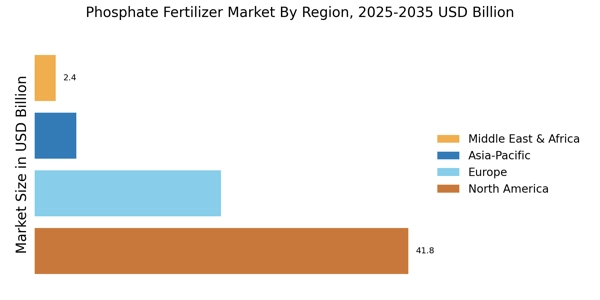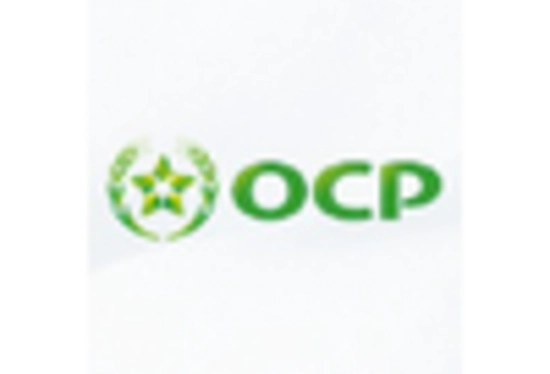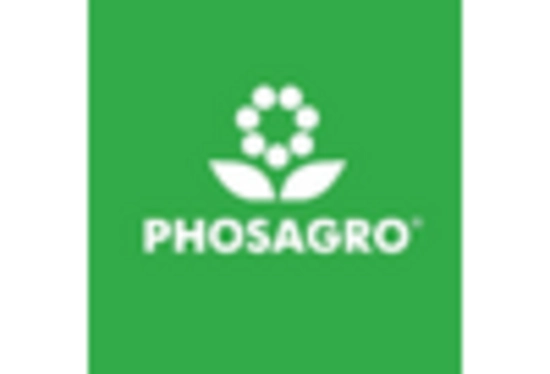Rising Food Demand
The increasing global population and changing dietary preferences are driving the demand for food production, which in turn propels the Phosphate Fertilizer Market. As populations grow, the need for higher agricultural yields becomes paramount. According to recent estimates, food production must increase by approximately 70% by 2050 to meet the needs of the burgeoning population. This surge in food demand necessitates the use of phosphate fertilizers, which are essential for enhancing crop productivity. Farmers are increasingly relying on these fertilizers to ensure that they can meet the nutritional needs of their communities. Consequently, the Phosphate Fertilizer Market is likely to experience substantial growth as agricultural practices adapt to these demands.
Global Trade Dynamics
The dynamics of The Phosphate Fertilizer Industry. Trade agreements and tariffs can affect the availability and pricing of phosphate fertilizers across different regions. Countries that are major producers of phosphate rock, such as Morocco and the United States, play a pivotal role in the supply chain. Changes in trade policies or geopolitical tensions can lead to fluctuations in supply, impacting prices and availability in various markets. As nations strive for self-sufficiency in food production, the demand for locally sourced phosphate fertilizers may increase, further shaping the Phosphate Fertilizer Market. Understanding these trade dynamics is essential for stakeholders looking to navigate the complexities of the market.
Soil Health Awareness
There is a growing recognition of the importance of soil health in sustainable agriculture, which is influencing the Phosphate Fertilizer Market. Farmers and agricultural stakeholders are becoming more aware of how phosphate fertilizers contribute to soil fertility and crop health. Enhanced soil health leads to improved crop yields and resilience against pests and diseases. Recent studies indicate that phosphate fertilizers can significantly improve soil nutrient levels, which is crucial for sustainable farming practices. As awareness of soil health continues to rise, the demand for phosphate fertilizers is expected to increase, thereby driving growth in the Phosphate Fertilizer Market. This trend reflects a broader shift towards sustainable agricultural practices that prioritize long-term soil vitality.
Government Policies and Subsidies
Government policies and subsidies play a crucial role in shaping the Phosphate Fertilizer Market. Many governments are implementing policies aimed at promoting agricultural productivity and sustainability, which often include financial incentives for the use of phosphate fertilizers. These subsidies can lower the cost of fertilizers for farmers, encouraging their use and thereby boosting demand. Additionally, regulatory frameworks that support sustainable farming practices can further enhance the market for phosphate fertilizers. As governments recognize the importance of food security and environmental sustainability, the Phosphate Fertilizer Market is likely to benefit from favorable policy environments that promote the use of these essential agricultural inputs.
Technological Innovations in Fertilizer Production
Advancements in fertilizer production technologies are reshaping the Phosphate Fertilizer Market. Innovations such as precision agriculture and enhanced efficiency fertilizers are being adopted to optimize nutrient delivery to crops. These technologies not only improve the effectiveness of phosphate fertilizers but also reduce environmental impacts. For instance, the development of slow-release phosphate fertilizers allows for more efficient nutrient uptake by plants, minimizing waste and runoff. As these technologies become more prevalent, they are likely to enhance the overall productivity of phosphate fertilizers, thereby stimulating growth in the Phosphate Fertilizer Market. The integration of technology in fertilizer production is expected to play a pivotal role in meeting the increasing agricultural demands.


















Leave a Comment